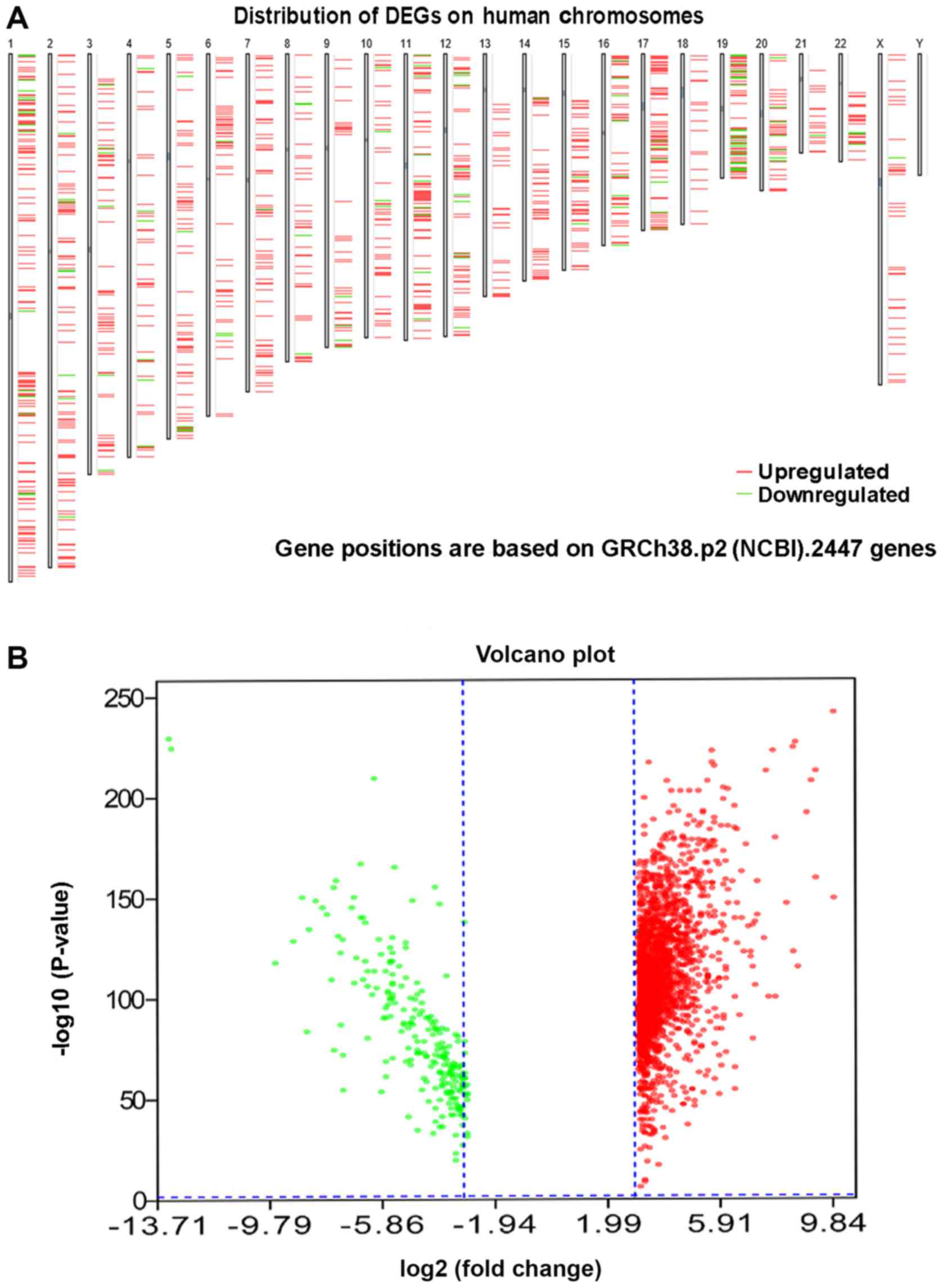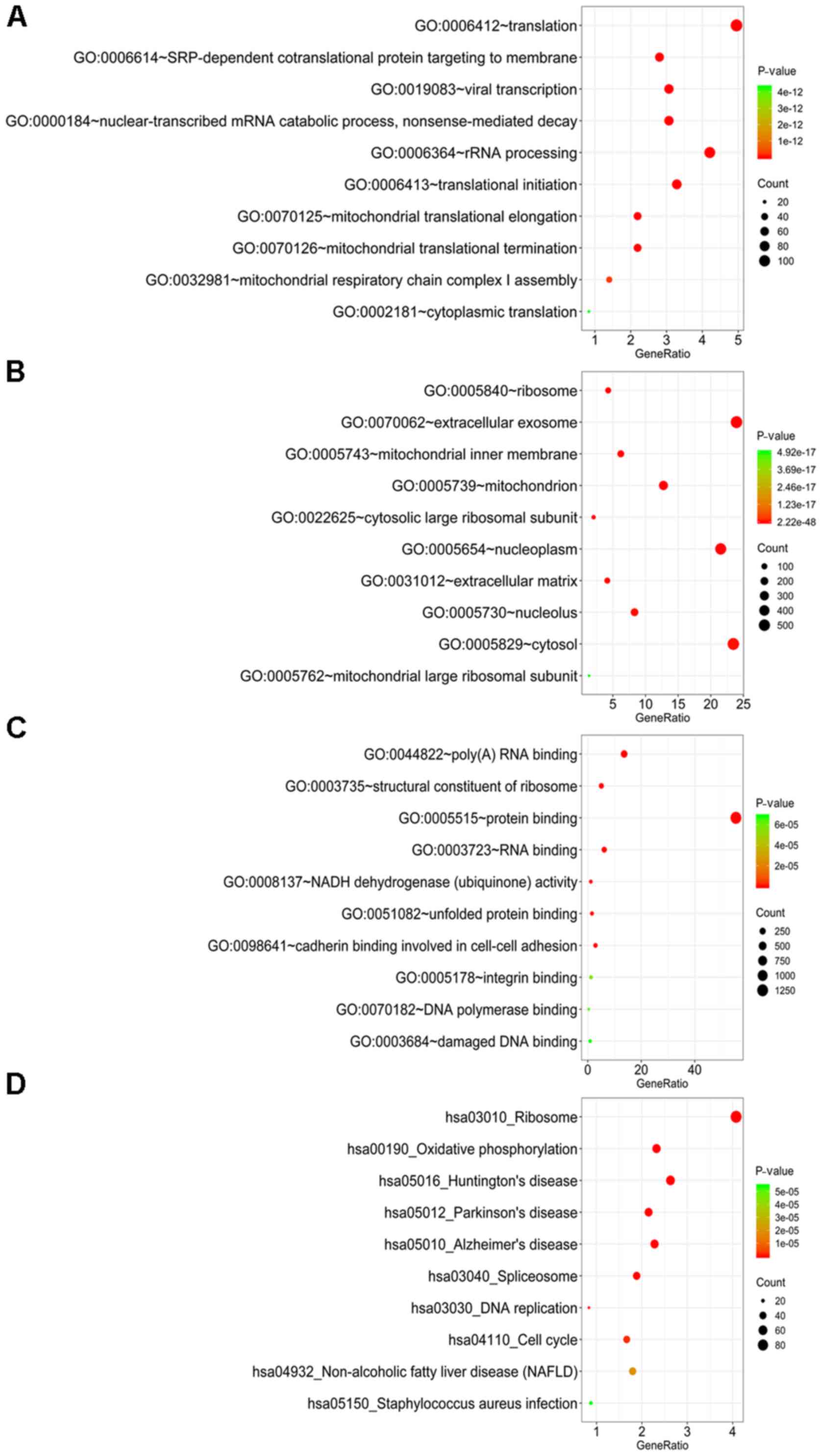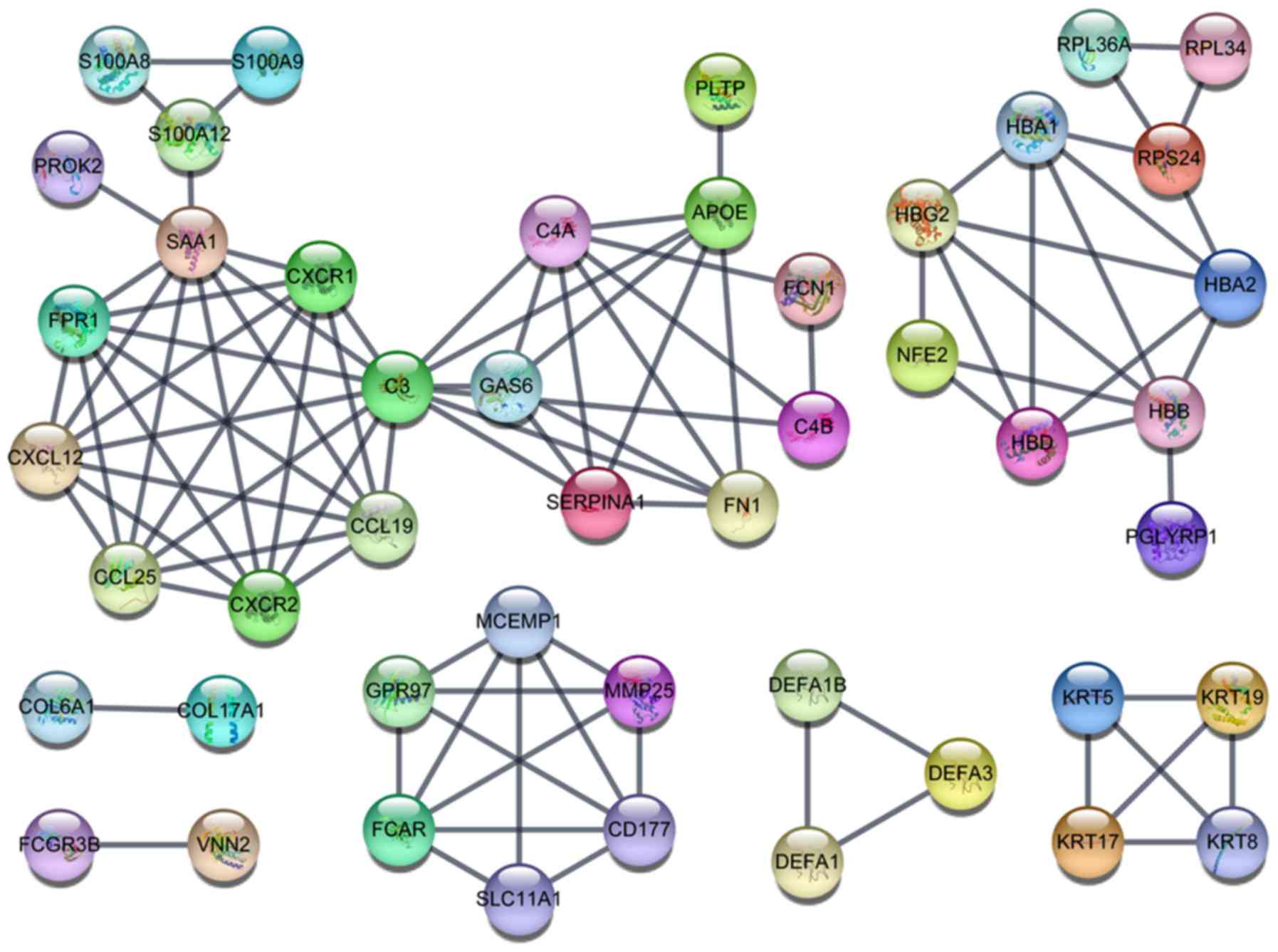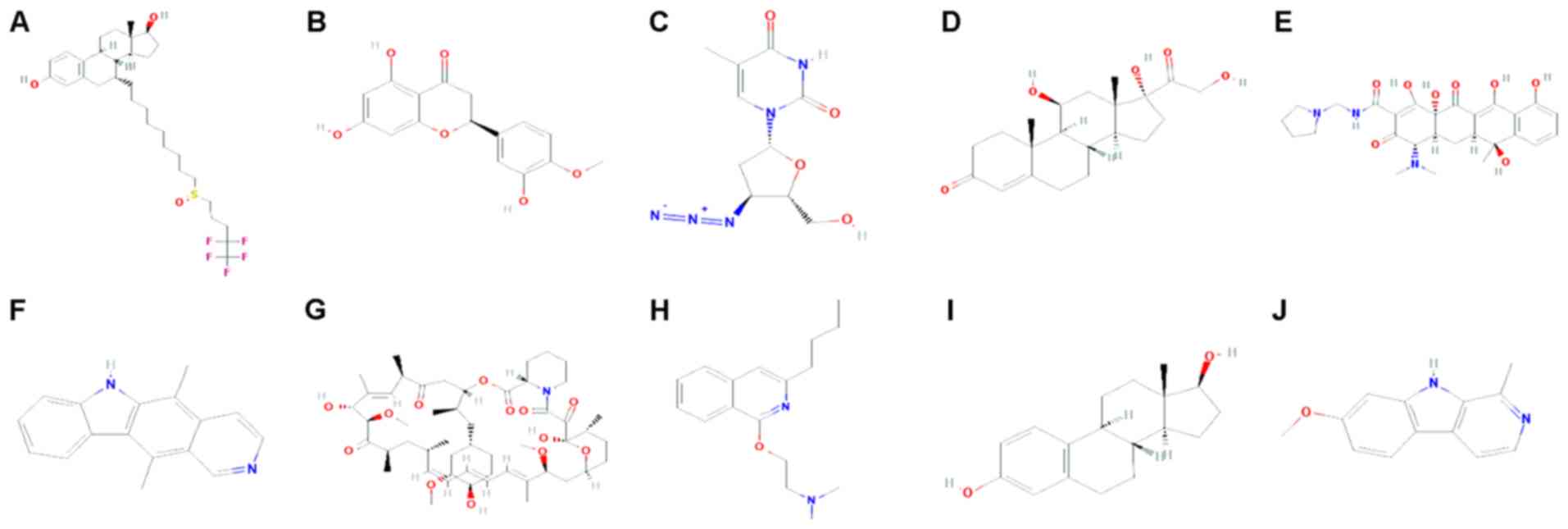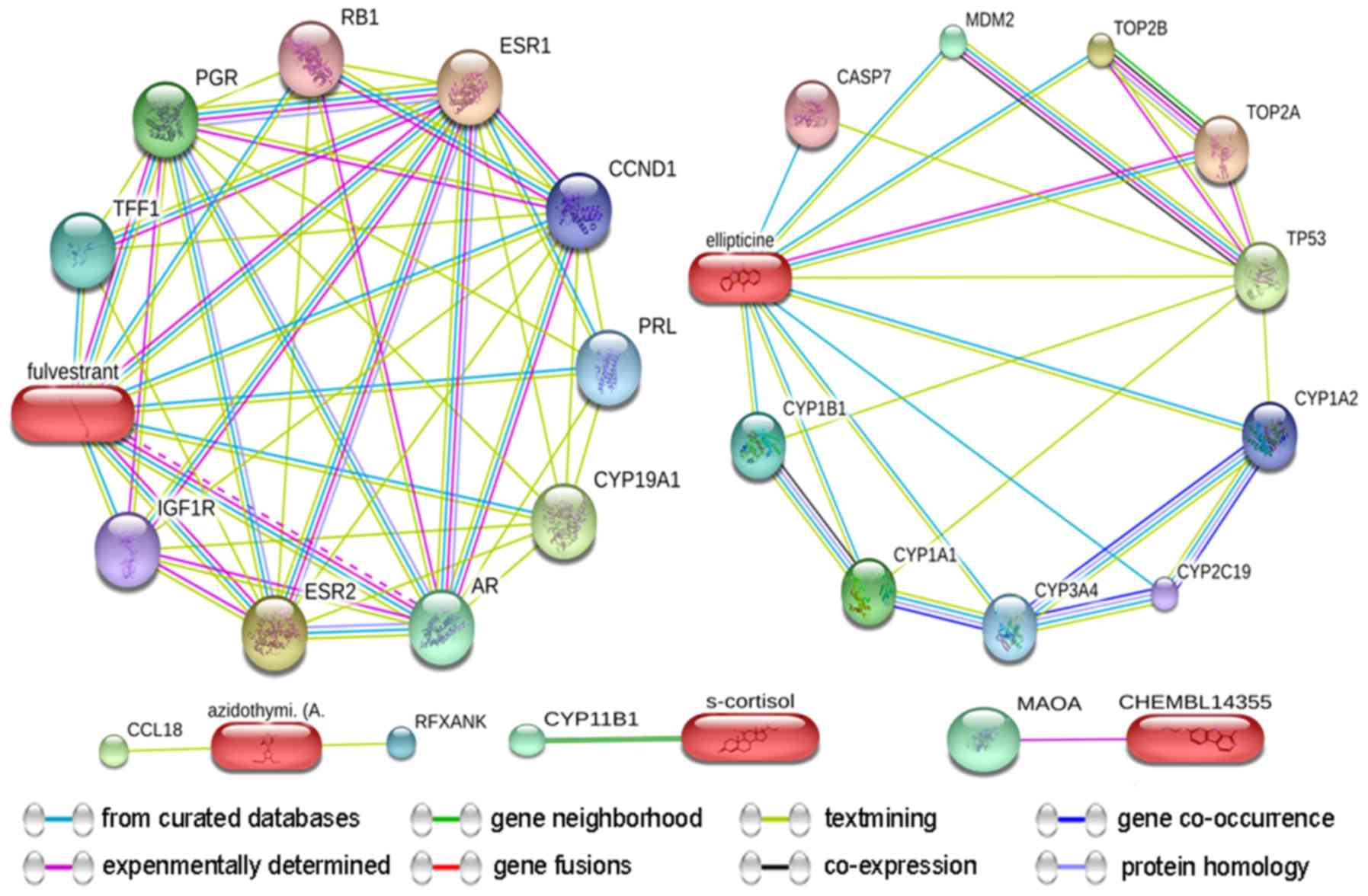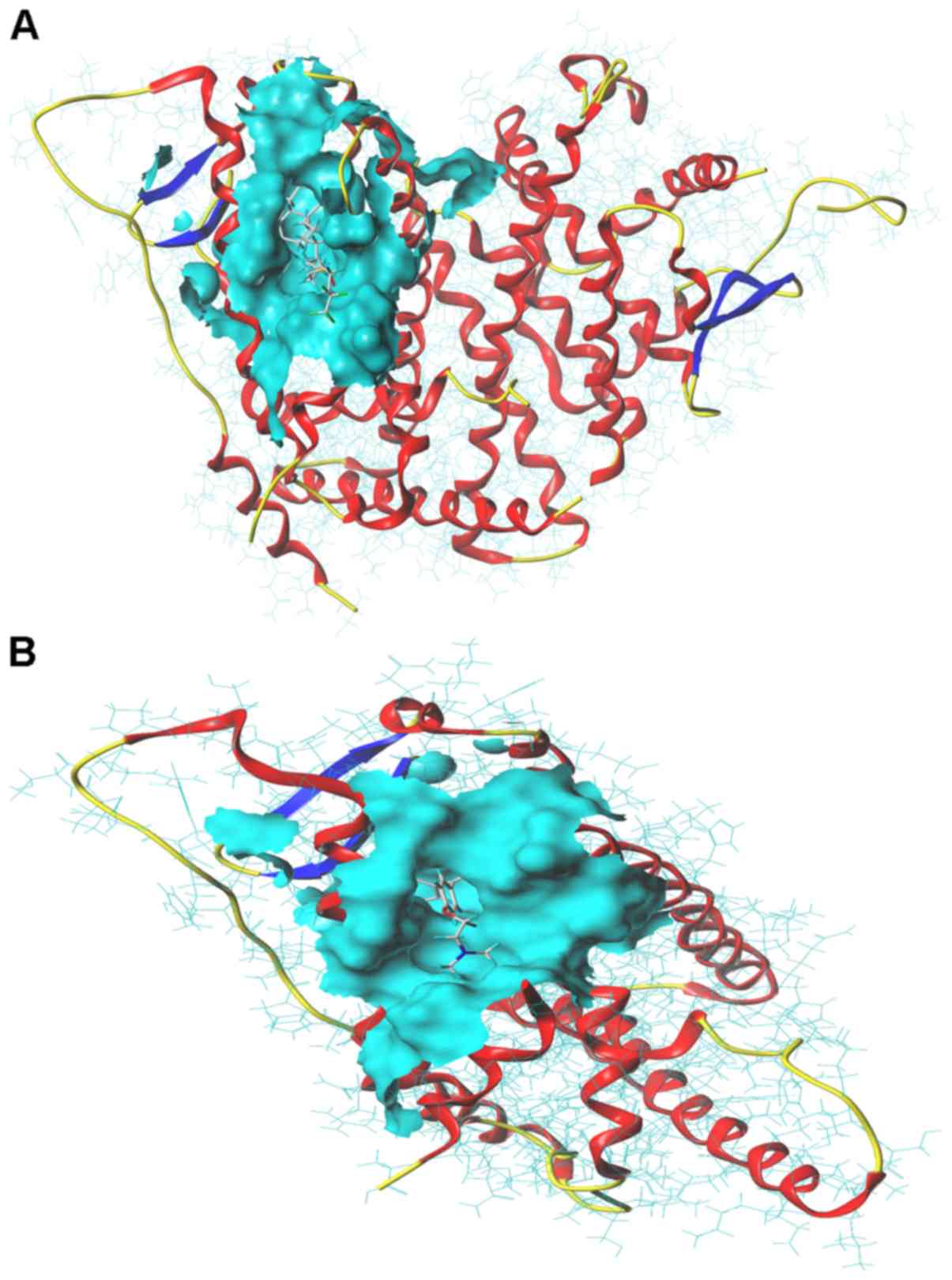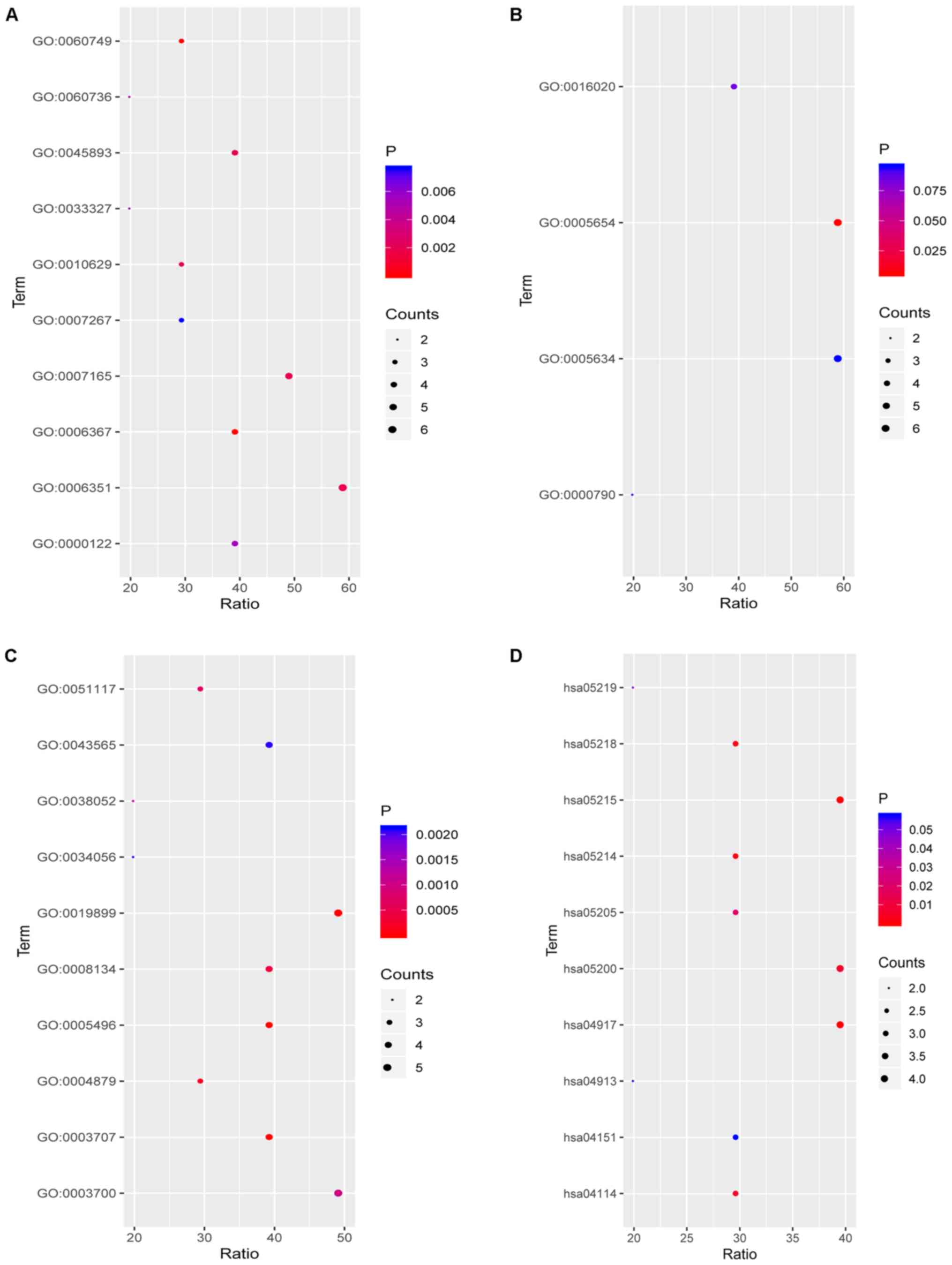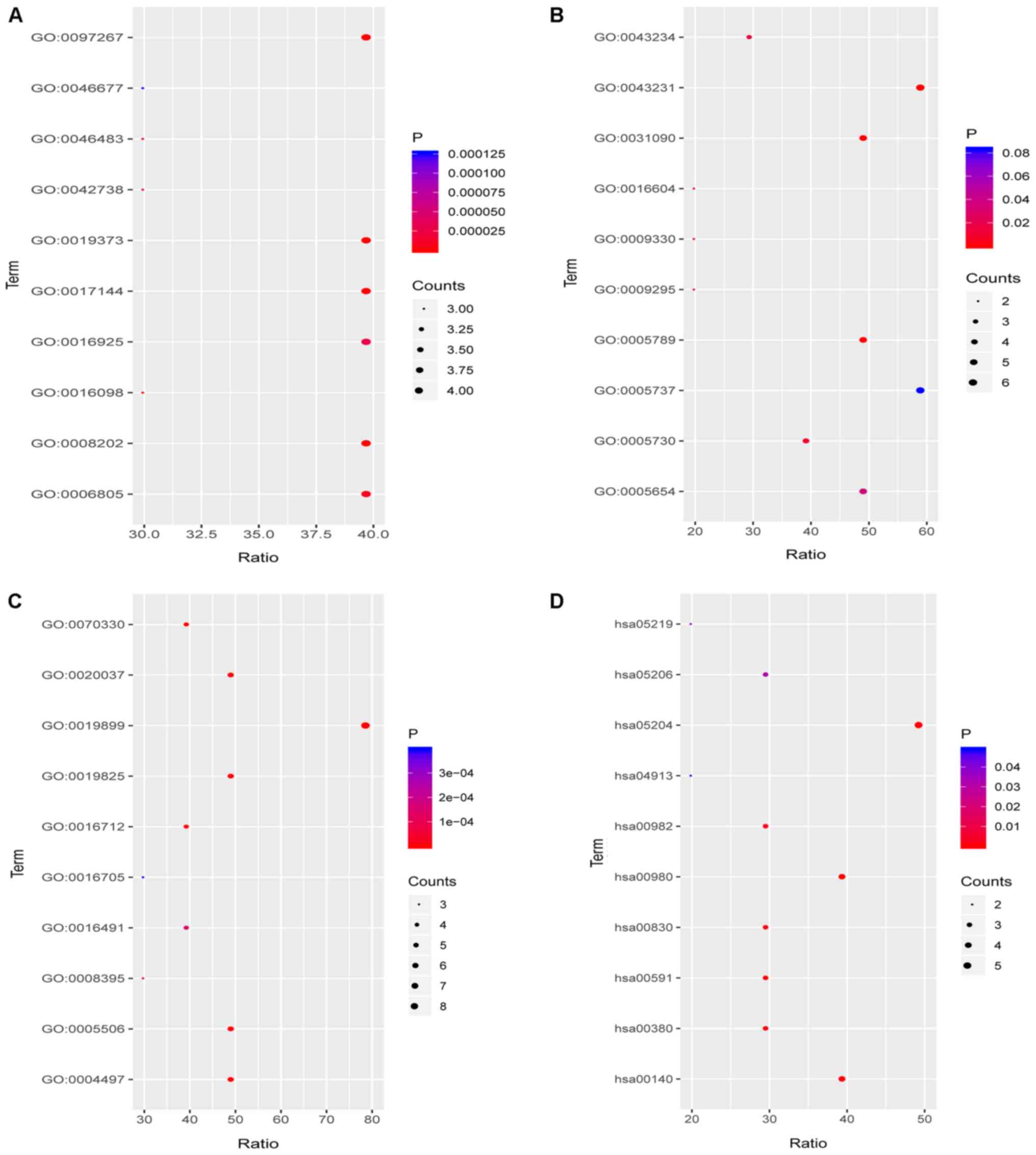|
1
|
Safieddine N, Liu G, Cuningham K, Ming T,
Hwang D, Brade A, Bezjak A, Fischer S, Xu W, Azad S, et al:
Prognostic factors for cure, recurrence and long-term survival
after surgical resection of thymoma. J Thorac Oncol. 9:1018–1022.
2014. View Article : Google Scholar : PubMed/NCBI
|
|
2
|
Thomas CR, Wright CD and Loehrer PJ:
Thymoma: State of the art. J Clin Oncol. 17:2280–2289. 1999.
View Article : Google Scholar : PubMed/NCBI
|
|
3
|
Kim DJ, Yang WI, Choi SS, Kim KD and Chung
KY: Prognostic and clinical relevance of the World Health
Organization schema for the classification of thymic epithelial
tumors: A clinicopathologic study of 108 patients and literature
review. Chest. 127:755–761. 2005. View Article : Google Scholar : PubMed/NCBI
|
|
4
|
Utsumi T, Shiono H, Kadota Y, Matsumura A,
Maeda H, Ohta M, Yoshioka Y, Koizumi M, Inoue T and Okumura M:
Postoperative radiation therapy after complete resection of thymoma
has little impact on survival. Cancer. 115:5413–5420. 2009.
View Article : Google Scholar : PubMed/NCBI
|
|
5
|
Ettinger DS, Riely GJ, Akerley W, Borghaei
H, Chang AC, Cheney RT, Chirieac LR, D'Amico TA, Demmy TL, Govindan
R, et al: Thymomas and thymic carcinomas: Clinical practice
guidelines in oncology. J Natl Compr Canc Netw. 11:562–576. 2013.
View Article : Google Scholar : PubMed/NCBI
|
|
6
|
Venuta F, Rendina EA, Pescarmona EO, De
Giacomo T, Vegna ML, Fazi P, Flaishman I, Guarino E and Ricci C:
Multimodality treatment of thymoma: A prospective study. Ann Thorac
Surg. 64:1585–1592. 1997. View Article : Google Scholar : PubMed/NCBI
|
|
7
|
Ma DL, Chan DS and Leung CH: Drug
repositioning by structure-based virtual screening. Chem Soc Rev.
42:2130–2141. 2013. View Article : Google Scholar : PubMed/NCBI
|
|
8
|
Kitchen DB, Decornez H, Furr JR and
Bajorath J: Docking and scoring in virtual screening for drug
discovery: Methods and applications. Nat Rev Drug Discov.
3:935–949. 2004. View
Article : Google Scholar : PubMed/NCBI
|
|
9
|
Lamb J, Crawford ED, Peck D, Modell JW,
Blat IC, Wrobel MJ, Lerner J, Brunet JP, Subramanian A, Ross KN, et
al: The Connectivity Map: Using gene-expression signatures to
connect small molecules, genes, and disease. Science.
313:1929–1935. 2006. View Article : Google Scholar : PubMed/NCBI
|
|
10
|
Tang Z, Li C, Kang B, Gao G, Li C and
Zhang Z: GEPIA: A web server for cancer and normal gene expression
profiling and interactive analyses. Nucleic Acids Res. 45:W98–W102.
2017. View Article : Google Scholar : PubMed/NCBI
|
|
11
|
He RQ, Qin MJ, Lin P, Luo YH, Ma J, Yang
H, Hu XH and Chen G: Prognostic significance of LncRNA PVT1 and its
potential target gene network in human cancers: A comprehensive
inquiry based upon 21 cancer types and 9,972 cases. Cell Physiol
Biochem. 46:591–608. 2018. View Article : Google Scholar : PubMed/NCBI
|
|
12
|
Huang da W, Sherman BT and Lempicki RA:
Bioinformatics enrichment tools: Paths toward the comprehensive
functional analysis of large gene lists. Nucleic Acids Res.
37:1–13. 2009. View Article : Google Scholar : PubMed/NCBI
|
|
13
|
Ni Z, Wang X, Zhang T, Li L and Li J:
Comprehensive analysis of differential expression profiles reveals
potential biomarkers associated with the cell cycle and regulated
by p53 in human small cell lung cancer. Exp Ther Med. 15:3273–3282.
2018.PubMed/NCBI
|
|
14
|
Huang da W, Sherman BT and Lempicki RA:
Systematic and integrative analysis of large gene lists using DAVID
bioinformatics resources. Nat Protoc. 4:44–57. 2009. View Article : Google Scholar : PubMed/NCBI
|
|
15
|
Liang L, Wei DM, Li JJ, Luo DZ, Chen G,
Dang YW and Cai XY: Prognostic microRNAs and their potential
molecular mechanism in pancreatic cancer: A study based on The
Cancer Genome Atlas and bioinformatics investigation. Mol Med Rep.
17:939–951. 2018.PubMed/NCBI
|
|
16
|
Szklarczyk D, Santos A, von Mering C,
Jensen LJ, Bork P and Kuhn M: STITCH 5: Augmenting protein-chemical
interaction networks with tissue and affinity data. Nucleic Acids
Res. 44:D380–D384. 2016. View Article : Google Scholar : PubMed/NCBI
|
|
17
|
Musa A, Ghoraie LS, Zhang SD, Glazko G,
Yli-Harja O, Dehmer M, Haibe-Kains B and Emmert-Streib F: A review
of connectivity map and computational approaches in
pharmacogenomics. Brief Bioinform. 19:506–523. 2018.PubMed/NCBI
|
|
18
|
Dalma-Weiszhausz DD, Warrington J,
Tanimoto EY and Miyada CG: The affymetrix GeneChip platform: An
overview. Methods Enzymol. 410:3–28. 2006. View Article : Google Scholar : PubMed/NCBI
|
|
19
|
Kim S, Chen J, Cheng T, Gindulyte A, He J,
He S, Li Q, Shoemaker BA, Thiessen PA, Yu B, et al: PubChem 2019
update: Improved access to chemical data. Nucleic Acids Res.
47:D1102–D1109. 2019. View Article : Google Scholar : PubMed/NCBI
|
|
20
|
Szklarczyk D, Franceschini A, Wyder S,
Forslund K, Heller D, Huerta-Cepas J, Simonovic M, Roth A, Santos
A, Tsafou KP, et al: STRING v10: Protein-protein interaction
networks, integrated over the tree of life. Nucleic Acids Res 43
(Database Issue). D447–D452. 2015. View Article : Google Scholar
|
|
21
|
Zhu D, Vaishampayan PA, Venkateswaran K
and Fox GE: STITCH: Algorithm to splice, trim, identify, track, and
capture the uniqueness of 16S rRNAs sequence pairs using public or
in-house database. Microb Ecol. 61:669–675. 2011. View Article : Google Scholar : PubMed/NCBI
|
|
22
|
Homer RW, Swanson J, Jilek RJ, Hurst T and
Clark RD: SYBYL line notation (SLN): A single notation to represent
chemical structures, queries, reactions, and virtual libraries. J
Chem Inf Model. 48:2294–2307. 2008. View Article : Google Scholar : PubMed/NCBI
|
|
23
|
Koelmel JP, Ulmer CZ, Jones CM, Yost RA
and Bowden JA: Common cases of improper lipid annotation using
high-resolution tandem mass spectrometry data and corresponding
limitations in biological interpretation. Biochim Biophys Acta Mol
Cell Biol Lipids. 1862:766–770. 2017. View Article : Google Scholar : PubMed/NCBI
|
|
24
|
Preston S, Jiao Y, Baell JB, Keiser J,
Crawford S, Koehler AV, Wang T, Simpson MM, Kaplan RM, Cowley KJ,
et al: Screening of the ‘Open Scaffolds’ collection from Compounds
Australia identifies a new chemical entity with anthelmintic
activities against different developmental stages of the barber's
pole worm and other parasitic nematodes. Int J Parasitol Drugs Drug
Resist. 7:286–294. 2017. View Article : Google Scholar : PubMed/NCBI
|
|
25
|
Ru J, Li P, Wang J, Zhou W, Li B, Huang C,
Li P, Guo Z, Tao W, Yang Y, et al: TCMSP: A database of systems
pharmacology for drug discovery from herbal medicines. J
Cheminform. 6:132014. View Article : Google Scholar : PubMed/NCBI
|
|
26
|
Wardell SE, Ellis MJ, Alley HM, Eisele K,
VanArsdale T, Dann SG, Arndt KT, Primeau T, Griffin E, Shao J, et
al: Efficacy of SERD/SERM Hybrid-CDK4/6 inhibitor combinations in
models of endocrine therapy-resistant breast cancer. Clin Cancer
Res. 21:5121–5130. 2015. View Article : Google Scholar : PubMed/NCBI
|
|
27
|
Fribbens C, O'Leary B, Kilburn L, Hrebien
S, Garcia-Murillas I, Beaney M, Cristofanilli M, Andre F, Loi S,
Loibl S, et al: Plasma ESR1 mutations and the treatment of estrogen
receptor-positive advanced breast cancer. J Clin Oncol.
34:2961–2968. 2016. View Article : Google Scholar : PubMed/NCBI
|
|
28
|
Lebeau A, Grob T, Holst F,
Seyedi-Fazlollahi N, Moch H, Terracciano L, Turzynski A, Choschzick
M, Sauter G and Simon R: Oestrogen receptor gene (ESR1)
amplification is frequent in endometrial carcinoma and its
precursor lesions. J Pathol. 216:151–157. 2008. View Article : Google Scholar : PubMed/NCBI
|
|
29
|
Dean JL, Thangavel C, McClendon AK, Reed
CA and Knudsen ES: Therapeutic CDK4/6 inhibition in breast cancer:
Key mechanisms of response and failure. Oncogene. 29:4018–4032.
2010. View Article : Google Scholar : PubMed/NCBI
|
|
30
|
Finn RS, Dering J, Conklin D, Kalous O,
Cohen DJ, Desai AJ, Ginther C, Atefi M, Chen I, Fowst C, et al: PD
0332991, a selective cyclin D kinase 4/6 inhibitor, preferentially
inhibits proliferation of luminal estrogen receptor-positive human
breast cancer cell lines in vitro. Breast Cancer Res. 11:R772009.
View Article : Google Scholar : PubMed/NCBI
|
|
31
|
VanArsdale T, Boshoff C, Arndt KT and
Abraham RT: Molecular pathways: Targeting the cyclin D-CDK4/6 axis
for cancer treatment. Clin Cancer Res. 21:2905–2910. 2015.
View Article : Google Scholar : PubMed/NCBI
|
|
32
|
Cristofanilli M, Turner NC, Bondarenko I,
Ro J, Im SA, Masuda N, Colleoni M, DeMichele A, Loi S, Verma S, et
al: Fulvestrant plus palbociclib versus fulvestrant plus placebo
for treatment of hormone-receptor-positive, HER2-negative
metastatic breast cancer that progressed on previous endocrine
therapy (PALOMA-3): Final analysis of the multicentre,
double-blind, phase 3 randomised controlled trial. Lancet Oncol.
17:425–439. 2016. View Article : Google Scholar : PubMed/NCBI
|
|
33
|
Mary Lazer L, Sadhasivam B, Palaniyandi K,
Muthuswamy T, Ramachandran I, Balakrishnan A, Pathak S, Narayan S
and Ramalingam S: Chitosan-based nano-formulation enhances the
anticancer efficacy of hesperetin. Int J Biol Macromol.
107:1988–1998. 2018. View Article : Google Scholar : PubMed/NCBI
|
|
34
|
Choi EJ: Hesperetin induced G1-phase cell
cycle arrest in human breast cancer MCF-7 cells: Involvement of
CDK4 and p21. Nutr Cancer. 59:115–119. 2007. View Article : Google Scholar : PubMed/NCBI
|
|
35
|
Sambantham S, Radha M, Paramasivam A,
Anandan B, Malathi R, Chandra SR and Jayaraman G: Molecular
mechanism underlying hesperetin-induced apoptosis by in silico
analysis and in prostate cancer PC-3 cells. Asian Pac J Cancer
Prev. 14:4347–4352. 2013. View Article : Google Scholar : PubMed/NCBI
|
|
36
|
Sivagami G, Vinothkumar R, Bernini R,
Preethy CP, Riyasdeen A, Akbarsha MA, Menon VP and Nalini N: Role
of hesperetin (a natural flavonoid) and its analogue on apoptosis
in HT-29 human colon adenocarcinoma cell line-a comparative study.
Food Chem Toxicol. 50:660–671. 2012. View Article : Google Scholar : PubMed/NCBI
|
|
37
|
Zhang J, Song J, Wu D, Wang J and Dong W:
Hesperetin induces the apoptosis of hepatocellular carcinoma cells
via mitochondrial pathway mediated by the increased intracellular
reactive oxygen species, ATP and calcium. Med Oncol. 32:1012015.
View Article : Google Scholar : PubMed/NCBI
|
|
38
|
McLeod GX and Hammer SM: Zidovudine: Five
years later. Ann Intern Med. 117:487–501. 1992. View Article : Google Scholar : PubMed/NCBI
|
|
39
|
De Clercq E: HIV resistance to reverse
transcriptase inhibitors. Biochemical pharmacology. 47:155–169.
1994. View Article : Google Scholar : PubMed/NCBI
|
|
40
|
Palacios R and Sugawara I: Hydrocortisone
abrogates proliferation of T cells in autologous mixed lymphocyte
reaction by rendering the interleukin-2 Producer T cells
unresponsive to interleukin-1 and unable to synthesize the T-cell
growth factor. Scand J Immunol. 15:25–31. 1982. View Article : Google Scholar : PubMed/NCBI
|
|
41
|
Schuttemeyer W and Reiff K: Clinical
observations on the broad spectrum antibiotic reverin. Dtsch Med J.
10:90–91. 1959.(In German). PubMed/NCBI
|
|
42
|
Sehgal SN: Sirolimus: Its discovery,
biological properties, and mechanism of action. Transplant Proc. 35
(Suppl 3):S7–S14. 2003. View Article : Google Scholar
|
|
43
|
Hengartner MO: The biochemistry of
apoptosis. Nature. 407:770–776. 2000. View Article : Google Scholar : PubMed/NCBI
|
|
44
|
Okasha SA, Ryu S, Do Y, McKallip RJ,
Nagarkatti M and Nagarkatti PS: Evidence for estradiol-induced
apoptosis and dysregulated T cell maturation in the thymus.
Toxicology. 163:49–62. 2001. View Article : Google Scholar : PubMed/NCBI
|
|
45
|
Zoller AL, Schnell FJ and Kersh GJ: Murine
pregnancy leads to reduced proliferation of maternal thymocytes and
decreased thymic emigration. Immunology. 121:207–215. 2007.
View Article : Google Scholar : PubMed/NCBI
|















